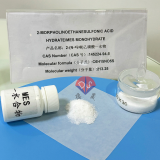- Category :
Other Chemicals/Others
- CAS NO : 145224-94-8
- EC NO :
- Molecular Formula : C6H13NO4S��H2O
- Main Specifications : White Powder
- Synonyms : MES.H2O;2-Morpholinoethanesulfonic acid, monohydrate;MES��H2O;
Package: 500g/bottle
Uses : Biological buffer
Molecular Structure:

Product description:
2- (N-morpholine) ethanesulfonic acid monohydrate, commonly referred to as MES monohydrate, is a commonly used biochemical buffer widely used in fields such as molecular biology and cell biology. As an effective pH buffer, it has stable chemical properties and good biocompatibility. Below, we will provide a detailed introduction to the properties of MES monohydrate.
1、 The properties of MES monohydrate
The molecular structure of MES monohydrate includes a morpholine ring, ethyl chain, and sulfonic acid group, with the molecular formula C6H15NO5S H2O, these structures endow MES monohydrate with a series of special properties. It can effectively adjust the pH value, has good buffering performance, is a white powder at room temperature, easily soluble in water, and its molecular structure has a low dissociation constant due to the sulfonic acid group, suitable for use in a wide pH range. At the same time, it is relatively stable under conventional storage conditions and not easy to decompose, which provides convenience for its application in biological experiments. 2、 Synthesis of MES monohydrate
At present, the synthesis methods of MES monohydrate mainly include direct synthesis method and indirect synthesis method:
1. The direct synthesis method involves a substitution reaction between morpholine and corresponding sulfonyl chloride, followed by hydrolysis to obtain the target product.
2. The indirect synthesis method uses morpholine derivatives and corresponding sulfonates as raw materials to prepare MES monohydrate through esterification or amidation reactions.
Although these methods differ, they all involve key reaction steps such as substitution, hydrolysis, esterification, and amidation.
 CN ChemNet > Gold Suppliers > Hubei new DE sheng material science and technology co., LTD. >
CN ChemNet > Gold Suppliers > Hubei new DE sheng material science and technology co., LTD. > 